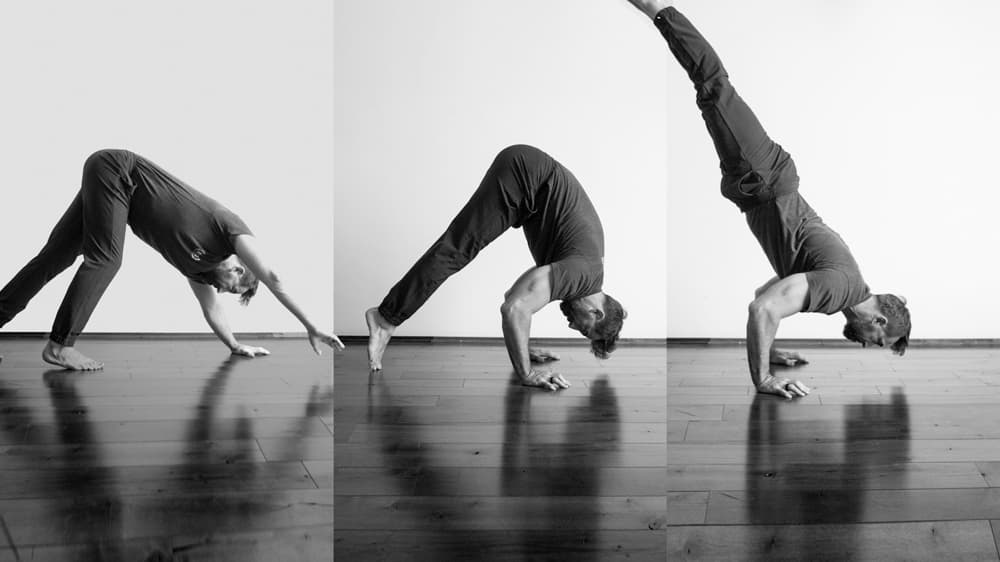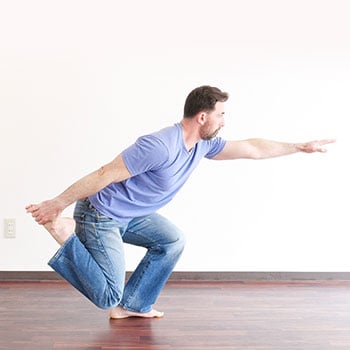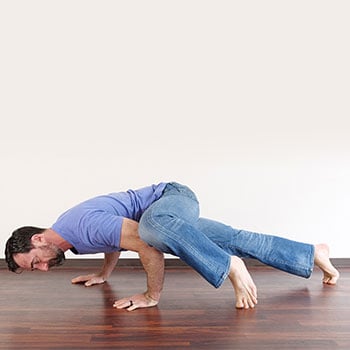“Which GMB program should I do first?”
Since we launched our second program back in 2010, this has been the number one question we get asked on a daily basis. And (spoiler?), for most people, the answer is Elements.
But you’re probably still wondering where the rest of the programs fit in…
First the good news:
- There’s almost no wrong way to use GMB programs.
And now for the bad news:
- There’s almost no wrong way to use GMB programs.
Having worked with many thousands of people across many backgrounds and situations, we design our programs to be flexible and “modular,” in the sense that they can fit together in different ways to suit different needs.
Of course, all those options add up to complexity, and that can be overwhelming.
So we also designed them to function as a complete curriculum you can follow to build strength, flexibility, and body control without having to worry about how they fit together.
Just start at the beginning and take it step-by-step.
Here’s how…
The GMB Core Curriculum
Most people will get the best results by taking the Core Curriculum in order to build a broad base of General Physical Preparedness.

The path from Elements, to Integral Strength and/or Mobility, and on to Sequences will systematically develop your overall physical capability to move with freedom and intention.
Let’s look at how each program functions as part of the Core Curriculum…
1. Elements: Your Foundation for Productive Training
“Wow! Four animal moves? I can just learn that from YouTube…”
If we were smarter, we would have made it look a whole lot more complicated and doubled the price. But there’s some sophisticated stuff happening beneath the surface.
Elements Details
Secret Sauce
But the real secret sauce is in how the program design teaches autoregulation with our built-in self-rating system, low-intensity options, and timed set durations.
Who it's for...
Pre-Requisites
But don’t get the wrong impression… this isn’t just a beginner-level program. It’s been used by Olympic athletes and competitors in many sports. You can see an example of how Elements get’s more challenging here.
Program Options
- Gradual: Designed for beginners or anyone who’s returning to training after an injury. The Gradual track starts gently and progresses at a gradual pace.
- General: Elements Classic. This is the right choice for most people and progresses from the very basics up to more complex movements.
- Accelerated: This track is aimed at people who’ve already completed the General track or have done similar programs before. It also includes more advanced and difficult variations of certain movements and progresses at a faster rate.
Recommended Schedule
Most people should start with 15-minute sessions, even if you’ve done other training before and think it’ll be easier. This is because Elements puts you in unusual positions which will take time for your body to get used to.
Over time, work up to a target of 90-120 minutes per week.
If you’re using Elements alongside other training, you can either use 15-minute sessions as a warm-up or do 30-45 minutes between your main workouts to build mobility and aid recovery.
2. Integral Strength / Mobility: Attribute Development
Depending on your background, you may already be working on building your strength, endurance, mobility, agility, etc.
So we split the second level of the Curriculum into two complementary programs. This gives you the option to choose one or both, which ever best fills the gaps in the other training your done or activities you’re involved in.
Integral Strength
Where most strength programs progress by adding reps or load (or moving to a harder exercise), we also introduce complexity to build stability and power in practical, athletic movement patterns.
Integral Strength Details
Secret Sauce
It’s a lot to get into here, but the gist is that as you get stronger, you can do more, higher quality reps in the same amount of time. So your training “density” naturally increases, without sacrificing quality.
Who it's for...
Pre-Requisites
- Enough hand, wrist, and elbow strength to comfortably do a few push-ups (don’t worry about the number… we’ll work on that during the program)
- The ability to squat to parallel without knee discomfort.
Program Options
- Bodyweight Only: The easiest option requires no equipment at all, yet provides a full-body strength workout (including your back).
- Bodyweight + Bar: Adding a bar allows us to include hanging exercises like pull-ups and increase the overall dfficulty level of the program.
- Bodyweight + Rings: The most challenging version of the program uses gymnastic rings for several exercises to build even greater strength and stability.
Recommended Schedule
If you’re doing IS alongside a sport or activity, we recommend twice per week.
Mobility: Yep, it’s… a mobility program
Mobility is a low-intensity, full-body approach to improving your easily accessible range of motion in all your major joints.
Secret Sauce
Stretching + Movement.
Each session uses a PNF-based stretching protocol to open up greater range of motion. But if you stop there, your nervous system will return to baseline, and you’ll wake up the next day just as stiff as you were before.
So after the stretch, we use specific locomotor movements to train your CNS to use and allow the new range to be accessed in active motion.
That means faster, more practical flexibility gains.
Who it's for...
We sometimes hear from people who find the exercises difficult because they are very stiff. And yes, that honestly shouldn’t be surprising, should it? I mean, if you could already do it easily, you wouldn’t need to practice would you? 🤣
In other words, almost anyone can do it, but if you are stiff, you kinda have to expect that it won’t be easy at first.
Pre-Requisites
Program Options
Recommended Schedule
You can also use Mobility as a short warm-up for other training.
If you use Mobility alongside Integral Strength it’s usually best to do them on different days. Alternating the programs each day is a popular option.
3. Sequences: Applied Movement Skill
It builds on movements, strength, and mobility built in the prior programs and applies them to more dynamic and complex skills, combo routines, and movement flows.
Sequences Details
Secret Sauce
That’s a lot, but we’ve arranged everything to build naturally from just 8 main building blocks. Those are grouped into combos, and the combos come together to build two longer flow routines.
It’s the systematic progression and practice of transitions that makes these flows accessible and enjoyable.
Who it's for...
Pre-Requisites
You should also try the Sequences self-assessment to be sure.
Program Options
- Flux Capacity: 30 or 45 minute sessions including both skill and conditioning work.
- Skill Dynamics: 15 or 30 minute sessions covering skill work, only.
Recommended Schedule
Electives: The GMB Supplemental Curriculum
Choose Supplemental programs to solve problems or pursue interests. You can add these in any order, alongside any Core program.

Restoring Healthy Physical Function
- All You Knee’d is Load: Fix knee pain with variable loading of the knee joint and exercises for hip and ankle mobility.
- Respiration: Bring awareness and control to your breathing for better performance and recovery.
- Recovery: Low-intensity movement and stretching to relieve muscle soreness and speed recovery.
Specific Attribute Development
- Static but Deadly: Isometric and compression exercises for static strength and stability.
- Get Flex and Chill: 12 follow-along stretch routines for specific activities and goals.
- Triple Shot Conditioning: 3-in-1 cardio and conditioning program.
Skills and Applied Strength
- Floor Loco: Learn 5 fun and challenging flow routines to develop transitional control and agility.
- Muscle-Up Course: Systematically build the strength and technique for strict muscle-ups on gymnastic rings.
Longevity Focused Training
- Resilience: Targeted joint strengthening exercises to resist injury in unpredictable situations.
- Literal Immortality: Specifically address the factors that most strongly correlate with a long, active lifespan.
- Momentum: Annual physical and mental reset to lay the groundwork for a year of productive training.
Supplemental Curriculum Details
How do I choose?
For supplemental training, I suggest choosing according to the following hierarchy:
- If you have pain or dysfunction, address that first.
- Next, address any lagging weak points that are limiting your progress.
- If you have neither of the above, pick whatever looks like the most fun.
Pre-Requisites
- Floor Loco: You should be comfortable with the movements in Elements.
- Literal Immortality: Nothing specific, but just don’t assume that this is an “easy” course for old people…
- Muscle-Up Course: You’ll need to be able to do 5 solid pull-ups.
When are you guys gonna make a program for _______?
Buffet Theory: Constructing a Balanced Routine
If you’ve ever been to a fancy buffet, you’ve probably made the mistake of trying to pile too many things onto your plate. Some chicken, some prime rib, a bit of salad, a different kind of salad, one of those little mini-quiches…
And you can’t really enjoy any of it, because you’ve just got a couple bites of a hundred different things.
But the secret of a buffet is this: you can go back as many times as you want.
You can have some of everything if you spread it out over a few helpings.

The same is true of your training.
A lot of people ask us how to combine all the programs, because they think that will make a more “complete” routine. But each program is already complete. They’re just focused on different things.
I suggest picking ONE main course.
One program from the Core Curriculum. The exception to that rule would be using Integral Strength and Mobilty together, because they were designed to work that way.
Then choose ONE or TWO side dishes, no more.
Add some spice with Floor Loco, or aim for more balanced overall health with Literal Immortality.
Then go back for another plate later on 🙂
It Just Works
Like I said at the beginning, the programs are made to be modular, so it’s very hard to use them in a way that won’t work.
But don’t let that complexity confuse you.
For best results, simply follow the Core Curriculum, and add Supplemental programs as suit your individual needs and interests.
Save Big and Lock In Access to Our Full Curriculum
All-In gives you that and more in a convenient and cost-effective membership.









